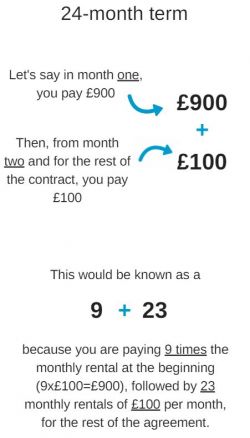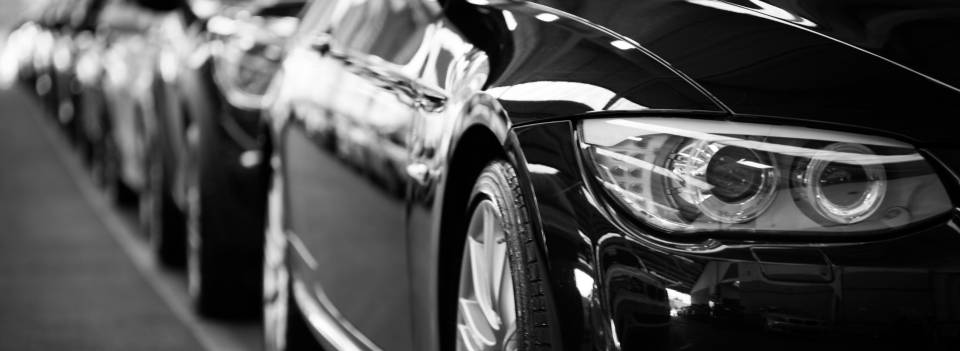Personal car leasing, also known as Personal Contract Hire (or PCH for short), is like renting a car, but usually over much longer period. You’ll likely keep your lease car for between two and four years, and can only lease brand-new vehicles.
Once you’ve decided how long you want a vehicle for, you pick your annual mileage and get a quotation for a lease deal. Then, you’ll have the freedom to tailor your lease deal with how little or how much you want to pay up front. This is known as the payment profile… Let us explain.
Rentals and payment profiles
Most personal lease agreements are made up of an initial rental, followed by a regular monthly rental for the duration of the contract. Let’s say you take a lease car for over 2-year term, which is 24 months.
Now let’s imagine you pay £900 in month one, followed by £100 per month for the remaining 23 months. This would be a 9+23.
This is because you paid the value of 9 monthly rentals at the start, which is followed by a further 23 monthly rentals of £100.
A 9+23…!
If this deal was £600 in month one, followed by 23 monthly rentals of £100 per month, it would be know as a 6+23.

What's included in a personal lease?
All personal lease vehicles supplied by motorlet are brand new and come from franchised dealerships in the UK. This means a whole range of things are included. Firstly, they come with the full manufacturer’s warranty, the same as if you were to drive it straight out of the dealership yourself. The fact that your lease car is brand-new will mean you won’t have to MOT it for three years.
All leases include the road fund licence (road tax) for the full duration of the contract, and in most cases, the manufacturer also provides you with breakdown cover, which is another cost you don’t need to worry about.
You also have the option of including a maintenance package, which covers all your servicing costs and, if you want to include them, tyres too. If you decide not to include it and choose to maintain the vehicle yourself, this is no problem, you just pay for it as you go.
Including it does add a few pounds to the monthly rental, but in the long run it can save you money.
Nearly every lease deal also includes free UK delivery and collection, so you don’t have to go anywhere to pick it up. The car can be delivered to any address, whether that be home, office, airport, and in most cases, you can even give permission for someone to sign for it on your behalf.
Insuring a lease car has never been easier. With the leasing industry in the UK growing every day, most insurers now offer the option to select ‘lease car’ when asking who owns the vehicle. Because you do not own the vehicle during the contract, as technically you’re just renting it, the lease company goes down as the registered owner and keeper. When insuring your lease car, you must have a fully comprehensive policy for the duration of your agreement.
Benefits of PCH
- Your monthly rentals are fixed every single month, from start to finish
- Access to more variety of vehicles
- You can choose from 5,000 - 50,000 miles per annum
- You choose the initial rental, putting down as much or as little as you like up front
- Flexible terms, allowing you to choose how long you have the car for (from 12 months to 5 years)
- Road tax included for the full duration
- All cars are brand new and come with a full manufacturer's warranty
- You can include a maintenance package that will cover you for routine servicing, MOTs, tyres, brake pads etc
Considerations for PCH
- Early termination fees can be expensive
- No option to buy the vehicle
- You must return the vehicle in a well maintained condition
- You may not be able to predict your annual mileage
- The vehicle must be insured full comprehensive
- You may have to pay for damage caused to the vehicle during the agreement
- If you go over your agreed mileage, you will have to pay a charge per mile
Although leasing is growing to be a one of the most popular ways to drive a brand new vehicle, it is not suitable for everyone. For example, you need specialist leases for vehicles used for hire and reward, such as taxis or chauffeurs services.
What happens at the end?
At the end of the contract the vehicle is handed back to the lease company, with no financial obligation to you, meaning you are free to source your next car in any way you see fit, be it lease, finance, or purchase.
When your lease comes to an end and the vehicle is collected, you may face potential charges. One charge that you may face is an excess mileage penalty. This will be an issue if you go over your agreed mileage, but you'll know how much each mile is going to cost you at the point of sale.
A charge may apply if the vehicle is given back damaged or mis-maintained (i.e. serviced with incorrect parts or handed back with bald tyres) beyond the established industry standard, set by the BVRLA (British Vehicle Rental and Leasing Association). This is know as Fair Wear and Tear. You can find out more about Fair Wear and Tear here.




